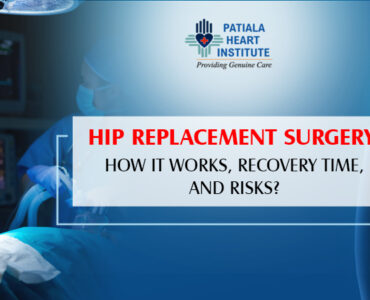Imagine waking up one day, and suddenly, a sharp, shooting pain courses through your back, radiating down your leg like an electric shock. Simple movements become excruciatingly painful.
The symptoms described above may indicate you have a herniated disc, and you should seek treatment for herniated disks as soon as possible.
A herniated disc is a common spinal condition that can lead to a variety of painful symptoms and discomfort. Understanding the signs and symptoms of a herniated disc is crucial because early recognition can make all the difference in your path to recovery.
What is a Herniated Disc?
Before understanding the signs and symptoms of a herniated disc, it is important to understand the spinal anatomy and what causes a herniated disc. Your spinal column is made up of 26 bones, called vertebrae, stacked upon each other, with discs between these bones acting as cushions.
The spinal cord also includes a bundle of nerves that travels through the spinal column, transmitting signals between your brain and the rest of your body. The discs, acting as shock absorbers, are composed of a tough outer layer (annulus) and a soft gel-like center (nucleus).
A herniated disc, also called a slipped disc or ruptured disc, occurs when the soft inner material pushes through a crack in the outer layer. This bulging or leaking material can irritate nearby nerves, resulting in a range of symptoms that vary depending on the location of the herniation.
Signs You May Have a Herniated Disc
Recognizing the signs and symptoms of a herniated disc is crucial for early diagnosis and prompt treatment. While not everyone experiences the same symptoms, here are some common indicators that you may have a herniated disc:
Pain in the affected area: Pain is the most prevalent symptom of a herniated disc. This pain can range from a dull, nagging ache to sharp, shooting sensations. The location of the pain depends on the disc’s location:
Cervical Herniated Disc (Neck): You may experience neck, shoulder, or arm pain.
Thoracic Herniated Disc (Upper Back): You might experience pain in the upper back and ribcage region. This pain may radiate around the chest or abdomen.
Lumbar Herniated Disc (Lower Back): Pain can radiate down the back, buttocks, and into one or both legs. This condition is often associated with sciatica.
Radiating Pain
A hallmark sign of a herniated disc is radiating pain that follows the path of the affected nerve. This can cause discomfort not only in the primary area but also in other parts of the body. For example:
Sciatica: If the herniation occurs in the lumbar spine, you may experience sciatica, characterized by pain radiating down the leg and into the foot. It can be accompanied by numbness and tingling.
Brachialgia: Herniations in the cervical spine can lead to brachialgia, causing pain, tingling, or weakness that radiates down the arm.
Numbness and Tingling
Alongside pain, you may experience numbness or tingling sensations in the areas served by the affected nerve. This can feel like pins and needles or a loss of sensation in the skin.
Muscle Weakness
Weakness in specific muscle groups may develop as a result of nerve compression, affecting your ability to perform everyday tasks. For example, if you have a herniated disc in your lower back, you might find it difficult to stand up from a sitting position or lift objects.
In severe cases, a herniated disc can impact your ability to walk or maintain balance due to muscle weakness or loss of sensation in the legs.
Difficulty with Activities
Everyday activities like walking, standing, or sitting may become challenging due to pain and discomfort. The pain might intensify during certain movements or positions.
In very severe cases, a herniated disc can compress the cauda equina nerves in the lower spine, leading to bowel or bladder dysfunction. This is a medical emergency that requires immediate attention.
It’s essential to keep in mind that not everyone with a herniated disc will experience all of these signs. The severity and combination of symptoms can vary from person to person. Additionally, the specific signs may depend on which part of the spine the herniated disc is affecting.
Common Causes and Risk Factors
Understanding the underlying causes and risk factors of a herniated disc is essential in recognizing your vulnerability to this condition and taking preventive measures. While herniated discs can happen to anyone, certain factors increase the likelihood of their occurrence.
Here are common causes and risk factors associated with herniated discs:
Aging and Natural Disc Degeneration: Our spinal discs naturally degenerate and lose some of their water content as we age. This makes them less flexible and more prone to herniation.
Trauma or Injury to the Spine: A sudden force or injury to the spine, such as a fall or car accident, can cause a disc to herniate.
Lifting and Posture-Related Factors: Improper lifting techniques and poor posture, especially when combined with heavy lifting, can increase the risk of disc herniation.
Genetic Predisposition: Some individuals may have a genetic predisposition to weaker spinal discs, making them more susceptible to herniation.
Treatment Options
The treatment approach for a herniated disc depends on several factors, including the severity of symptoms, the location of the herniation, and the individual’s overall health. Here are some common treatment options for a herniated disc:
Conservative Approach
- Rest: Taking a break from activities that worsen the symptoms can help reduce inflammation and promote healing.
- Physical Therapy: Targeted exercises and stretches can improve strength and flexibility, alleviate pain, and prevent further injury.
Pain Management
- Medications: Over-the-counter pain relievers, muscle relaxants, or prescription medications can provide relief from pain and inflammation.
- Epidural Injections: Corticosteroid injections into the spine can provide temporary relief from pain and inflammation.
Lifestyle changes
Maintain a Healthy Weight: Excess weight can increase the stress on your spine and exacerbate herniated disc symptoms.
Proper Posture: Learning and practicing good posture can help prevent future disc problems.
Ergonomic Changes: Make adjustments in your workplace or home to reduce strain on your neck and back.
Regular Exercise: Engaging in low-impact exercises such as swimming, walking, and cycling can help strengthen the muscles that support your spine. These activities can also improve flexibility and overall spinal health.
Quitting Smoking: If you smoke, quitting can significantly benefit your spinal health. Smoking is associated with reduced blood flow to spinal discs, which can hinder healing and contribute to disc degeneration.
Surgical Interventions
When conservative approaches, medication, and lifestyle changes are unable to provide adequate relief, surgical intervention may be required. Some surgical procedures used for the treatment of a herniated disc are:
Discectomy: In this procedure, the herniated portion of the disc is removed to relieve pressure on the nerves.
Laminectomy: A laminectomy involves the removal of a portion of the vertebral bone to create more space for the nerves.
Intrathecal Drug Delivery: Also known as spinal drug delivery systems or infusion pain pumps, this advanced medical technology administers medication directly into the spinal fluid for precise pain management.
Spinal Cord Stimulation Implants: The implant offers pain relief by modulating nerve signals in the spinal cord, helping patients manage chronic pain conditions effectively and improving their quality of life. The implant blocks the pain signals from reaching the brain.
When to Seek Medical Help?
Dealing with the symptoms of a herniated disc can be challenging, and knowing when to seek medical help is crucial for timely intervention.
Remember that early diagnosis and appropriate treatment can help prevent the condition from worsening and may reduce the need for surgery. If you experience severe weakness, numbness in the groin or genital area, or loss of bladder or bowel control, don’t hesitate to reach out to a healthcare professional for a thorough evaluation and guidance on herniated disc treatment options.
For advanced herniated disc surgery and comprehensive treatment, consider Patiala Heart Institute, a leading multispecialty hospital in Patiala. Our expert team specializes in herniated disc treatment, including surgical interventions when necessary. Contact us today to schedule a consultation.
What Are The 4 Stages Of Disc Herniation?
The four stages of disc herniation are:
- Disc Degeneration (Bulging): The initial stage where the disc begins to wear down.
- Disc Prolapse: The inner gel-like material pushes against the outer layer but remains contained.
- Disc Extrusion: The inner material breaches the outer layer but is still connected to the disc.
- Disc Sequestration: The inner material completely separates from the disc and may migrate into the spinal canal.
What Are The Best Sleeping Positions To Sleep With A Herniated Disc?
The best sleeping positions for a herniated disc are typically those that maintain the spine's natural curvature. These include sleeping on your back with a pillow under your knees, on your side with a pillow between your knees, or in a fetal position. Avoid sleeping on your stomach, as it can strain the neck and lower back.







